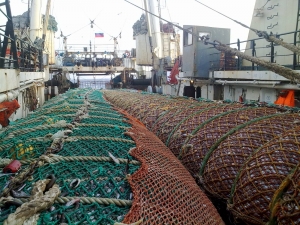
By data of Vessel Daily Reports (VDR) contained in the FMS, pollock catch by pelagic trawls in a commercial fishing mode in the RF EEZ (target fishery) by all ships of the flotilla totaled about 889.5 kt by April 10, 2020 (Table 1) which is more than a year before (817.2 kt).
Another 25.0 kt (23.8 kt in 2019) was harvested by other fisheries, primarily the Danish seine fishery off West Kamchatka. Total catch in the unified Subzones 61.05.2 and 61.05.4 in January – March 2020, harvested by all fishing gear types, was 575.2 kt or nearly 51.7 kt more than in the preceding year. Total pollock catch in the Season A of 2020 was 914.0 kt (85.9% of TAC) compared with 841.1 kt (87.2% of TAC) during the same period in 2019.
In general, daily pollock catch by all vessels in the northern part of the Sea of Okhotsk during the 2020 fishing season was gradually growing, as more catchers became engaged and more fishing operations were performed: from 0.6 kt in early January to 7.6 kt in mid-January (see Fig. 4.2.1). Then, daily catch reduced to 2.9 kt by January 26 and abruptly grew to 10.6 kt by month’s end. It remained roughly on the same level till late February – approx. 9.4 kt. Then this parameter was gradually increasing and reached its maximum of 13.9 kt on March 26. Then daily catch was gradually declining and amounted to some 10.0 kt by the end of the fishing season. Mean daily catch per fishing season was 9.1 kt (8.5 kt in last year) and mean catch per ship was 99.6 tons (84.2 tons in last year).
In total, 127 ships of various types operated in the target trawl fishery during the 2020 fishing season which is the smallest number over last 10 years. As a consequence, total number of ship-days in this year was considerably smaller than in last year – 8,417 and 9,034 respectively. Despite this and primarily due to larger catches per effort, pollock yield in Season A of 2020 significantly surpassed yield in the same period of last year.
This year’s fishing season can be assessed as successful in terms of total yield and daily catches. January and February were more productive months in comparison with last year.
The pollock stock in the northern part of the Sea of Okhotsk is currently at a high level which is confirmed by fishery results. Given that the assumed two-year-olds’ average abundance over last 10 years is 9.5 billion individuals, total pollock stock will grow to 9.7 million tons in 2020 due to full addition of medium-strength cohorts of 2013–2014 to its fishable stock biomass, while its spawning stock biomass, on the contrary, will somewhat decrease and amount to approx. 6.4 million tons.
In temperature terms, the winter of 2020 was warmer than usual but colder than in 2019 when unusually high surface temperatures were observed in January and February. The amount of ice cover in 2020 was by approx. 5% smaller than normal, while in 2019 it slightly exceeded its multi-year mean, which is explained, first of all, by cold and icy March. The most unfavorable fishing conditions in terms of wind speed and wave height occurred on January 24–25 and March 12–15 when mean daily wind speed was 12–16 m/s and mean daily wave height was 3–5 m with an absolute maximum of 5.6 m (March 12). In comparison with 2019, in the winter of 2020 mean wind speed over the season was lower and wave height, on the contrary, higher.
From the viewpoint of qualitative composition of pollock catches in the northern part of the Sea of Okhotsk, fishing conditions were generally favorable. The bulk of catches consisted of individuals 37–41 cm long belonging to medium-strength year classes of 2013–2014. Same as in last year’s fishing season, increased by-catch of pollock juveniles was observed in occasional hauls in some areas and, first of all, in the area in vicinity of the 57th parallel.
The observers of VNIRO’s Far Eastern branches have collected a large volume of fishing and biological information which is still to be processed and thoroughly analyzed. These data will be used for assessments of current and future status of the North Sea of Okhotsk pollock stock and for estimations of TAC for 2022.
